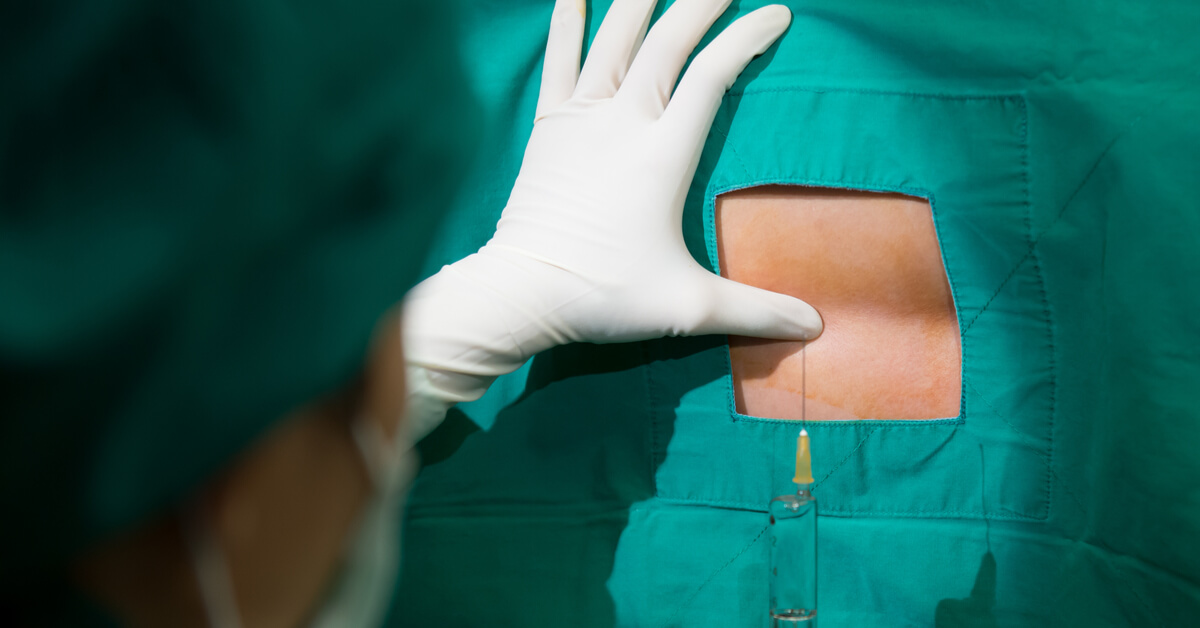What Is Epidural?
Epidural, a form of anesthesia, commonly referred to as local anesthesia, stands as the predominant method for pain relief during giving birth. This involves injecting anesthetic and painkillers into the back region, targeting the spinal cord.
The primary goal of an epidural is to numb the nerves in the spinal cord, disrupting the transmission of pain signals. The regional numbness it provides allows the patient to remain conscious while being relieved of pain and sensation.
Application in Labour: A Vital Component When considering anesthesia during giving birth, the question of epidurals invariably arises. Epidurals for labour are employed in deliveries where the lower part of the waist is numbed through the application of local anesthesia.
Two Approaches to Epidurals:
- Natural Birth (Vaginal Delivery) with Epidural: This involves numbing the lower part of the waist using local anesthesia for pain relief during vaginal delivery.
- Caesarean Section (C-Section) with Epidural: In the case of a caesarean section, the lower back area is fully anesthetised, utilising both pain relievers and local anesthetics. During this process, the mother remains conscious without feeling pain. In natural delivery with an epidural, fewer local anesthetics and more pain relievers are typically administered. As a result, the mother doesn’t feel pain but retains the ability to sense touch.
Understanding these nuances helps expectant mothers make informed decisions about pain management during giving birth, aligning with their preferences and needs.
For expectant mothers, the topic of giving birth is a source of considerable contemplation. The anticipation of the moment and the method of giving birth often tops the list of questions and curiosities. The emotional mix of excitement and apprehension when cradling your newborn is entirely normal. During this period, mothers often envision bringing their baby into the world in a way that aligns with their preferences, prompting them to seek information through research.
Why Is Epidural Used?
If you’re considering getting an epidural, understanding the situations where this procedure is employed can be insightful. Epidurals are utilised in giving birth for two primary reasons:
- Reducing Labour Pains and Facilitating Natural Birth: Epidurals are commonly administered during giving birth to alleviate the sensation of labour pains, making the process more comfortable for the mother. This pain relief can facilitate a smoother natural birth.
- Involving the Mother-To-Be While Keeping Her Conscious: Epidurals enable the mother to remain conscious and alert during giving birth, actively participating in the birthing experience.
Beyond giving birth, epidurals find applications in various medical scenarios, including:
- Knee, hip, and foot surgeries
- Waist, neck, and inguinal hernia surgeries
- Some gynaecological procedures
- Alleviating pain caused by spinal cord disorders
- Managing post-operative pain
- Choosing local anaesthesia over general anaesthesia in certain cases
How to Administer Anaesthesia: A Step-by-Step Guide
Administering anaesthesia, particularly for an epidural, involves a precise process that an anaesthesiologist carefully follows. Here is a step-by-step guide:
- Patient Positioning:
- The patient assumes a lying or sitting position.
- Arching the back by pulling the head up to the chest is essential.
- The patient remains slouched and motionless throughout the procedure.
- Cleaning and Sterilization:
- The dorsal area, where the needle will be inserted, is thoroughly cleaned with an antiseptic solution to minimize infection risks.
- Sterile Attire:
- Following cleaning, the patient is dressed in a sterile green gown.
- Local Anaesthesia Application:
- Using a needle, local anaesthesia is applied to numb the area, ensuring the patient is pain-free during the procedure.
- Needle Placement:
- An epidural needle is carefully inserted into the numbed area.
- Catheter Insertion:
- Through the needle, a catheter is placed in the epidural space, the area between the outer membrane of the spinal cord and the inner surface of the spine.
- Catheter Fixation:
- The catheter is securely fixed in place.
- Needle Removal and Medication Delivery:
- After fixation, the needle is slowly removed.
- Analgesic medication is administered continuously or at regular intervals through the catheter.
The entire process typically takes about 10-15 minutes, ensuring the patient receives effective pain relief during giving birth or other medical procedures.
Benefits of Opting an Epidural
Choosing to get an epidural offers several advantages for expectant mothers:
- Reduced risk compared to general anaesthesia
- Faster and easier recovery
- Active participation in giving birth
- Witnessing caesarean section
- Less pain post-caesarean birth
- Facilitates long-term natural births
- Lower risks of bleeding and clot formation
- Emergency situations transition
- Reduced passage of anaesthetic substances to the baby
Understanding these benefits allows expectant mothers to make informed decisions regarding pain management during childbirth, tailored to their preferences and well-being.
Risks and Side Effects of Opting for Epidural
While epidurals are a widely used form of anaesthesia, like any medical procedure, they come with potential risks and side effects. It’s essential to note that epidurals generally have lower risk ratios compared to other forms of anaesthesia, contributing to their popularity.
- Lowered Blood Pressure:
- Epidurals may cause a temporary decrease in blood pressure, which can affect both the mother and, in rare instances, the baby’s heart rate.
- Common Complaints:
- Some common complaints associated with epidurals include dizziness, itching, low blood pressure, headache, nausea, and back pain.
- Temporary Leg Weakness:
- There may be a temporary weakness in the legs following an epidural.
- Potential Impact on Labour:
- In rare cases, epidurals may slow down the progress of labour by eliminating the sensation of straining.
- Effect of Position:
- Remaining in the same position post-procedure may contribute to a slower labour progression. Therefore, it’s recommended to move around as much as possible.
- Temporary Nerve Damage:
- There is a rare possibility of temporary nerve damage during catheter insertion. The likelihood of this occurrence is closely tied to the expertise of the anaesthesiologist.
- Low Infection Risk:
- While there is a very low chance of infection, the risk is minimized with the use of appropriate antiseptic solutions.
Understanding these potential risks and side effects allows expectant mothers to make informed decisions about pain management during giving birth and weigh the benefits against the potential drawbacks.
To Whom Is Epidural not Performed?
In some special cases, epidural may not be appropriate. Especially those with chronic diseases should be investigated whether they are suitable for the procedure. It should be examined in detail by the doctor and anaesthesia should be performed after the necessary controls are made.
Epidural is not preferred in the following cases:
- If you take blood thinners
- If you have some bleeding and coagulation problems
- If there is a low platelet count in the cells that will clot the blood
- If you have an infection in the area where the epidural will be performed
- If your blood pressure is extremely low
- If there is excessive bleeding
- If you have high blood pressure
- If you have a neurological disorder
- If there is a tumour that will increase intracranial pressure
- If you have an allergic condition to anaesthesia drugs
As we conclude this exploration into epidural, it’s essential to recognise that the decision to opt for pain management during giving birth is a personal one, tailored to individual preferences and health considerations. Epidural, with its advantages and potential drawbacks, stands as a widely chosen method offering pain relief during both natural and caesarean births. By understanding the procedure, its benefits, and associated risks, expectant mothers can make informed choices, easing the fear of giving birth and fostering a healthier experience for both themselves and their babies. We invite you to share your thoughts, questions, and experiences as we continue to navigate the diverse and exciting realm of pregnancy and giving birth!
Wishing you a journey filled with comfort, confidence, and the joy of welcoming new life!








